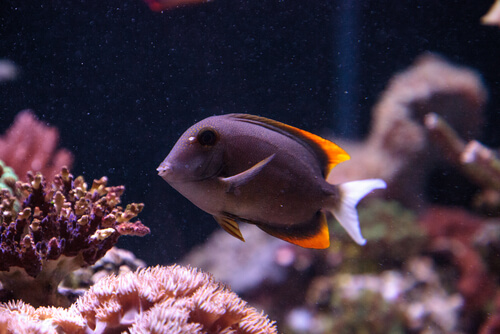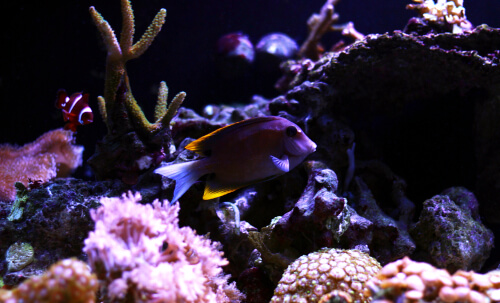Tomini Tang: Care, Size, Where to Purchase & More
Posted by on 5/09/2023
We use affiliate links and may receive a small commission on purchases.
Hobbyists looking for a fish that's full of personality should look no further than the Tomini tang. These fish, which hail from the Indo-Pacific, are known for their active personalities and the color changes they undergo as they transition to adult fish.
While you may jump at the opportunity to purchase such a unique species, tang fish, including the Tomini, do present a unique set of challenges that hobbyists should be aware of. In this post, we'll cover the ins and outs of the Tomini tang, and we'll also recommend best practices when it comes to feeding, tank setup, and more.
Species Summary
The Tomini Tang (scientific name: Ctenochaetus tominiensis) is also known as the Tomini surgeonfish, or Bristletooth Tomini Tang. These fish can be found throughout the Indo-Pacific, off the islands of Indonesia, and as far east as the islands of Tonga.
Similar to other surgeonfish, the Tomini tang has a scalpel-like spine, which it uses to protect itself and ward off potential predators. The fish is quite small compared to other tang fish, and will only grow to be about 6 inches in length. When compared to other surgeonfish, the Tomini tang has earned a reputation of being a bit more peaceful, but temperament still varies between individual fish.

Appearance
The Tomini Tang features a tan coloration with translucent pectoral fins. The fish's dorsal and anal fins are accented with a golden coloration, and the fish's face is adorned with small golden dots. Under actinic lighting, the fish's body will display a purple-like appearance.
Each side of the fish's tail has a bladelike spine, and when combined with a thrashing motion, can inflict a deep wound on a potential victim. Hobbyists will want to use caution when handling the fish, although rare, attacks can be quite painful. Always use gloves when servicing a tank containing a Tomini tang.

Juvenile vs Adult
Similar to the Kole Yellow Eye Tang, the Tomini Tang goes through a color change as it transitions into adulthood. As they age, their coloration will become a bit more vibrant and pronounced.
Tomini's will typically reach their adult stage at around 12 months of age.
Male vs Female
Male and female Tomini tangs are visually indistinguishable. While some tangs, such as the Blonde Naso display tail streamers based on gender, the Tomini tang does not.
Hobbyists should operate under the assumption that every Tomini tang is male, to prevent any territorial disputes from occurring.
Size
Tomini tangs are relatively small, and adults will only grow to be about 6 inches in length.
This puts the Tomini on the small end of surgeonfish sizes. For comparison, other species such as the Desjardini Tang can grow to reach a whopping 16 inches in length.
Tomini Tang Care
For many hobbyists, the biggest barrier to entry in keeping surgeonfish is the requirement of a large aquarium. Fortunately, the Tomini tang is a bit smaller, requiring a slightly smaller aquarium.
Still, hobbyists will want to provide plenty of rock work and pristine water conditions to ensure their Tomini reaches its full life expectancy.
Lifespan
In captivity, the Tomini Tang has a lifespan of about 5 years.
Hobbyists will want to provide stable water parameters and a well-balanced diet. Aggressive tank mates should also be avoided.
Tank Size
The Tomini Tang requires an aquarium that's at least 70 gallons in size.
Although the Tomini Tang is quite a bit smaller when compared to other tangs, this species is still a surgeonfish and requires plenty of room to swim and search for new food sources. Luckily for hobbyists, larger tanks are better at maintaining stable parameters, one of the most important aspects of fishkeeping.
Acclimation
Tomini tangs should be drip acclimated over 30 minutes using a reliable drip acclimation kit . After 30 minutes of acclimation, the fish should be netted and deposited directly into the display or quarantine tank.
To further reduce the risk of accidentally introducing harmful pathogens and diseases, you'll want to avoid adding the transport water into your display tank.
Water Conditions
The Tomini Tang is widespread throughout the Indo-Pacific, and you'll want to recreate their natural water conditions as closely as possible in captivity.
The following water parameters should be maintained when housing a Tomini Tang:
Ammonia: 0ppm
Nitrite: < .2ppm
Nitrate: < 10ppm
Specific Gravity: 1.020-1.025
Temperature: 72°F-78°F
dKH: 8-12 dKH
pH: 8.1-8.4
Tank Setup
Tomini Tangs are active swimmers, and hobbyists will want to set up their tanks accordingly. Providing plenty of open swimming space, while also creating caves and crevices using rockwork is ideal. In the wild, Tomini tangs live in areas with a lot of water movement, which can be recreated in captivity by adding an adjustable powerhead .
Although Tomini Tangs can live in bare-bottom tanks, we recommend a sand-based substrate, which contrasts nicely with the coloration of the fish.
Common Diseases
Surgeonfish are known to have a thin slime coat, and hobbyists should keep a close watch on any potential diseases.
Some of the most common diseases in the saltwater aquarium hobby are marine velvet and ich (which we cover in more detail in another one of our posts: Marine Velvet vs Ich: Similarities, Differences, Causes & Treatment). Quarantine procedures should always be in place before adding additional fish, especially one such as the Tomini Tang.
Food & Diet
Tomini tangs should be fed a diet consisting of mysis shrimp, brine shrimp, and nutrient-rich flake food at least 2-3 times per day.
As Herbivores, these tangs require plenty of plant-based foods to feed upon. Hobbyists should supplement their diet with nori sheets at least 3 times per week.
Behavior and Temperament
Although the species isn't as aggressive as the Purple Tang or Sohal Tang, the Tomini is still a surgeonfish and is known to be somewhat aggressive. Tomini tangs should be the only surgeonfish species in the aquarium. While hobbyists have kept multiple tangs in massive aquariums before, there is always the risk of encountering territorial disputes between the fish.
For the most part, the fish is quite active and is a fish that certainly appreciates the spotlight. Once acclimated, hobbyists will notice these fish frequently swimming in the center of the water column, where their big appetites will motivate them to hunt down any potential food sources.
Reef Compatibility
The Tomini Tang makes a great addition to a reef tank, but these herbivores do tend to pick at algae growing near any coral.
Blastos, chalices, and torches, are just a few potential coral options that look great in a tank housing a Tomini.
Tank Mates
Provided a large enough aquarium, Tomini Tangs will co-exist peacefully with a wide variety of marine fish.
Some potential tank mate options include:
Avoid aggressive species, such as the Blue Spotted Puffer, Niger Triggerfish, and Tessalata Eel. You'll also want to avoid adding more than one Tomini Tang to a tank, as males are aggressive toward each other, and females are visually indistinguishable.
Hobbyists planning on adding other surgeonfish, such as the Desjardini, Gem or Powder Blue should proceed with caution. Housing multiple surgeonfish can be challenging. You'll need a massive aquarium, and likely an acclimation box to safely introduce any new fish. Most importantly, you'll need a rehome plan in place in case you notice any aggressive behavior.
Breeding
There have not been any successful attempts at breeding the Tomini Tang in captivity. However, that doesn't mean that we won't see the Tomini tang receive a captive-bred designation in the near future.
With captive-bred success stories happening every year, and successful attempts from Quality Marine at breeding the Purple Tang , hopefully, we'll see the Tomini added to their list of captive-bred fish.
Where to Purchase
Tomini tangs are occasionally sold by vendors on our marketplace, but we've also seen these fish go up for sale on some of the larger online vendors like LiveAquaria.
Before purchasing, always inquire about the fish's age and current water conditions, so that you can successfully acclimate the species.
Conclusion
The Tomini Tang is a sought-after bristletooth tang that makes an excellent addition to a marine aquarium. The species is active, vibrant, and relatively easy to care for.
Now that you've learned a bit about this unique fish, do you plan on adding one to your saltwater aquarium? Let us know in the comments, and be sure to visit our marketplace and community forum.
December's Giveaways on Light Fish








